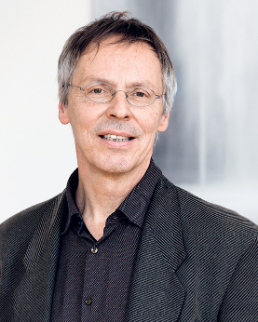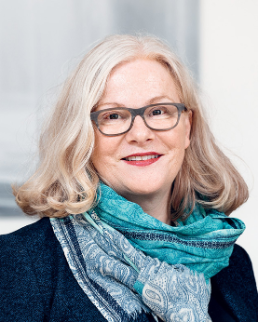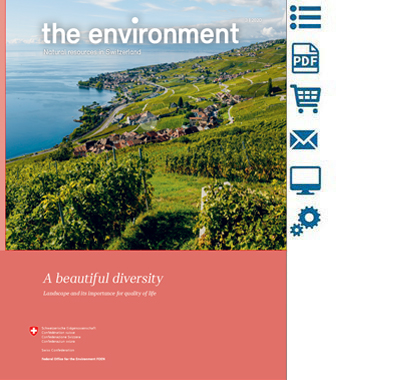The Council of Europe’s Landscape Convention defines landscape as “an area, as perceived by people”. Both human activity and the influence of nature feed into this perception. However, the way we view the landscape has changed over time, environment discussed this issue with Renate Amstutz, Director of the Swiss Union of Cities (SSV),and Raimund Rodewald, Head of the Swiss Foundation for Landscape Conservation (SL).
Interview: Lucienne Rey

© Severin Nowacki | Ex-Press | BAFU
The Council of Europe Landscape Award 2018–19 went to the renaturation of the River Aire near Geneva. Why do you think the jury reached this decision?
Raimund Rodewald: As far as landscape is concerned, this renaturation project represents a major step forward because it’s a rare example of collaboration between biology, nature conservation, architecture and spatial planning. These disciplines normally operate separately, but in this case they were all involved together. Also, the old configuration was recontextualised rather than simply eliminated, with the Aire’s former channel now serving as a walkway within the redesigned landscape. The result is a successful landscape transformation that exudes optimism.
Renate Amstutz: In fact, the project is about going “forward to nature” and attests to a new respect for the natural world. This is different from the past when we sought to tame nature by confining rivers in narrow channels. Another significant feature of the project is that it accommodates a range of different needs – habitat diversity, flood protection and recreation. The cooperation across national borders is also forward-looking.
We have plenty of positive words for describing landscapes – “charming”, “breathtaking”, “magical” and “lovely”, for example – but relatively few negative terms. Most of the time we make do with “scarred”, “sprawling” or “eyesore”. Given the massive changes currently affecting the landscape, why does the positive lexicon predominate?
Amstutz: “Landscape” is often taken to mean not landscape as a whole, but that part of it which hasn’t yet been changed. The commonly used terms express a kind of yearning and are bound up with what we feel needs to be conserved. And also, we generally prefer describing beautiful things!
Rodewald: Public surveys based on landscape photos reveal widespread agreement on which landscapes are aesthetically pleasing, but when people are asked about “ugly” landscapes, the answers are not so forthcoming. The problem with linking “beauty” and “landscape” in this way is that it completely overlooks landscapes where humans have functionally reshaped their world. We ignore precisely those spaces for which we need to create high-quality aesthetics. In this context, the holistic view taken by the European Landscape Convention is groundbreaking.
Amstutz: However, there are currently major changes under way, reflected for example in the adoption of the Second Home Initiative and the revision of the Spatial Planning Act. The efforts to promote inward settlement development and clear demarcation of building and non-building land show a concern for the environment in which we live. There is also an increasing focus on already transformed landscapes. We’re beginning to move beyond an idealised perception of the landscape to one that encompasses urban landscapes too.
And yet, particularly in films, cities with their skyscrapers and expanses of concrete are portrayed as oppressive and serve as backdrops to grim future scenarios. Why is that?
Amstutz: Dystopian plots concerning social conditions have to take place in man-made settings;an unspoilt natural setting wouldn’t really work. Megacities are the obvious choice. Also, there have been major failings in urban development in the past: nondescript, soulless neighbourhoods designed without input from local residents, and all too often blighted by social problems. Looking from a Swiss perspective, however, a more varied picture emerges: no megacities but a network of towns, cities and regional centres of all sizes that have evolved over time, each with its own character. What’s more, our towns and cities are changing, thanks to increasingly carefully designed architecture, intermediate and outdoor spaces, parks, expanses of water and green façades. A juxtaposition of old and new, including features that convey a sense of identity, allows places to be read, brings them to life and helps to tell their stories. The past 20 years have seen people moving back into towns and cities.
Rodewald: Swiss cities have improved enormously in terms of quality, and people are noticing that – but the general perception is lagging about 50 years behind reality. This is also reflected in the idealisation of the rural landscape, whose industrial features are concealed.

Directorate.
© Severin Nowacki | Ex-Press | BAFU
While the reputation of cities is on the up, the same is less true of their outskirts, the so-called agglomeration. Why is the prevailing view of these places ambivalent at best?
Amstutz: Our evidence suggests that the agglomerations are perceived less negatively than is often claimed. However, it is true that they face some major challenges. They are growing rapidly, and designing high-quality settlements with distinct identities is challenging. But people are now becoming much more aware of how important this is.
Rodewald: When communes profile themselves online, it’s striking how the same sort of characteristics are always cited: proximity to the centre and good transport links for speedy travel elsewhere. Whereas there’s hardly any mention of the qualities that would make people want to spend time in the local area. Many communes suffer from a lack of identity and the absence of a distinct centre. Because communes in the agglomerations are growing fast, little attention is paid to the design of green spaces and there’s a lack of joined-up thinking in the design of green spaces, open spaces and buildings.
Amstutz: But that is changing! Agglomeration programmes supported by the Confederation can only be approved if they are comprehensive in scope. Participation procedures too are increasingly holistic in nature, right down to the issue of diversity and coexistence.
Rodewald: But cities have the advantage over agglomerations of having neighbourhood associations that demand participation and have established a culture of debate. This is harder to organise in agglomerations, where communes tend to coalesce. And it’s conflicts that lead to the formation of campaign groups and the required engagement between the authorities and the population.
Do you think that the authorities’ perception of landscape is also changing?
Amstutz: When we look back at films from the 1960s enthusing over newly-built motorways, the fervour is hard for us to understand now. Our view of the landscape has become more holistic, as have planning requirements, and regulations are much stricter. These reflect changing perceptions within society.
Rodewald: However, thinking about settlement development from a landscape perspective requires extensive advice and consultation. The Federal Council’s Swiss Landscape Concept focuses heavily on advice and consultation as a way of harnessing an area’s individual potential and distinctive characteristics. This enables the specific quality of the landscape to serve as an anchor for identity. Working on these terms will also enable areas to be re-designed and new qualities created.
Amstutz: Yes, it’s about reading the space at a macro level while also maintaining specific characteristics at a micro level. The goal has to be to create residential neighbourhoods where people feel at home and are happy to spend time, rather than wanting to escape to somewhere else. In an era of globalisation, it’s important to satisfy people’s yearning for roots as they will treat the landscape more considerately if they feel rooted within it.
Social media influencers like to photograph themselves against spectacular backdrops. Do you think this could lead to a new-found appreciation of landscape?
Amstutz: On social media, I fear that beautiful surroundings are primarily there as decor for the individual. There’s little real engagement with the landscape – as shown by the accidents that happen in pursuit of selfies.
Rodewald: Concern is also my dominant feeling right now. But to give social media its due, it has also facilitated grassroots movements: for example, in some towns and cities where the council could no longer afford to maintain green spaces, residents have got together on social media to step into the breach. Landscape conservation starts with every square metre, and engaging with the landscape is key. People will only take responsibility for something if they feel part of it.
Further information
Last modification 02.09.2020






